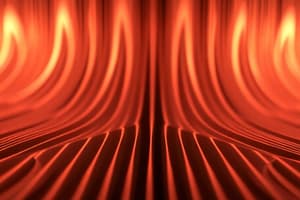Podcast
Questions and Answers
What is the primary physical process that enables laser action?
What is the primary physical process that enables laser action?
- Spontaneous emission
- Absorption
- Stimulated emission (correct)
- Reflective emission
Which property of optical fibers contributes significantly to their effectiveness in telecommunications?
Which property of optical fibers contributes significantly to their effectiveness in telecommunications?
- Immunity to electromagnetic interference (correct)
- High cost of installation
- Low bandwidth
- Vulnerability to physical damage
In holography, what do interference patterns created by coherent light enable?
In holography, what do interference patterns created by coherent light enable?
- The reflection of light through different materials
- The absorption of light energy
- The recording and reconstruction of three-dimensional images (correct)
- The scattering of light in all directions
What materials characteristic significantly affects the interaction of light when selecting materials for optical devices?
What materials characteristic significantly affects the interaction of light when selecting materials for optical devices?
What technology utilizes light to store and retrieve data at high densities?
What technology utilizes light to store and retrieve data at high densities?
What phenomenon is produced when two waves combine to create a larger amplitude?
What phenomenon is produced when two waves combine to create a larger amplitude?
Which of the following best describes the behavior of light in geometric optics?
Which of the following best describes the behavior of light in geometric optics?
What does diffraction refer to in the context of optics?
What does diffraction refer to in the context of optics?
How can light be polarized?
How can light be polarized?
In wave optics, which of the following is NOT a key concept?
In wave optics, which of the following is NOT a key concept?
What is the primary use of interferometers in engineering optics?
What is the primary use of interferometers in engineering optics?
Which statement about lasers is correct?
Which statement about lasers is correct?
What role does polarization play in optical technologies?
What role does polarization play in optical technologies?
Flashcards
Stimulated Emission
Stimulated Emission
The physical process that creates laser light, involving atoms emitting light of the same energy and phase as an incoming photon.
Optical Fiber Communication
Optical Fiber Communication
Using light pulses to send information through thin glass fibers for high-speed data transmission.
Holography
Holography
A technique to create 3D images using interference patterns produced by coherent light.
Optical Properties
Optical Properties
Signup and view all the flashcards
Laser Applications
Laser Applications
Signup and view all the flashcards
Optics
Optics
Signup and view all the flashcards
Wave Optics
Wave Optics
Signup and view all the flashcards
Geometric Optics
Geometric Optics
Signup and view all the flashcards
Interference
Interference
Signup and view all the flashcards
Diffraction
Diffraction
Signup and view all the flashcards
Polarization
Polarization
Signup and view all the flashcards
Optical Instruments
Optical Instruments
Signup and view all the flashcards
Lasers
Lasers
Signup and view all the flashcards
Study Notes
Introduction to Optics in Engineering Physics
- Optics is the branch of physics that studies the behavior and properties of light, including its interactions with matter.
- It encompasses a wide range of phenomena, from reflection and refraction to interference, diffraction, and polarization.
- Engineering physics applications of optics are diverse and crucial, including optical communication, imaging systems, and sensing technologies.
Wave Optics
- Light exhibits wave-like behavior, which is described by wave optics.
- Key concepts include wavelength, frequency, amplitude, and phase.
- Wave interference phenomena like constructive and destructive interference are crucial for understanding optical devices and systems.
Geometric Optics
- Geometric optics treats light as rays, which travel in straight lines.
- Key concepts for ray optics include reflection and refraction at surfaces of different mediums.
- Applications include lens design for cameras, microscopes, and other optical instruments.
- Laws of reflection and refraction govern ray propagation and image formation.
Interference
- Interference arises from the superposition of two or more waves.
- Constructive interference occurs when the waves combine to produce a larger amplitude.
- Destructive interference results in a smaller amplitude.
- Interference patterns are crucial for various applications involving wave propagation and measurement.
Diffraction
- Diffraction refers to the bending of waves around obstacles or openings.
- Diffraction patterns depend on the wavelength and size of the obstacles or openings.
- Diffraction plays a critical role in optical instruments and the analysis of light signals.
Polarization
- Polarization describes the direction of oscillation of the electric field vector in an electromagnetic wave.
- Light can be polarized through various mechanisms including reflection, scattering, and birefringence.
- Polarization is used in various optical technologies and applications.
Optical Instruments
- Various optical instruments utilize the principles of geometric and wave optics.
- Microscopes and telescopes rely on lenses and mirrors to magnify images and focus light.
- Interferometers measure extremely small distances, which finds applications in metrology and precision engineering.
Lasers
- Lasers generate coherent, monochromatic, and highly directional light beams.
- Stimulated emission is the physical process underlying laser action.
- Various types of lasers exist with different functionalities and applications.
- Laser applications are widespread ranging from medical treatments and industrial processing to optical communications.
Optical Fiber Communication
- Optical fibers transmit information using light pulses.
- They offer high bandwidth, low signal loss, and immunity to electromagnetic interference.
- Widely used in telecommunications and data transmission.
Holography
- Holography is a technique that captures and reconstructs three-dimensional images.
- It involves recording interference patterns created by coherent light.
- Holography has diverse applications in security, data storage, and other scientific areas.
Material properties and their effect on light
- Different materials interact with light in distinct ways.
- Indices of refraction, absorption coefficients, and scattering properties significantly influence the propagation and interaction of light within a material.
- Optical properties are vital characteristics to consider when selecting materials for specific optical devices.
Applications of Optics in Engineering Physics
- Optical sensors: Detect changes in light, enabling advanced measurement in different fields.
- Optical storage: Utilizes light to store and retrieve data at high densities.
- Optical imaging: Encompasses microscopy, imaging systems, and other techniques for visual analysis and diagnostics.
- Optical communication: Employs fiber optics for fast and efficient data transmission.
Studying That Suits You
Use AI to generate personalized quizzes and flashcards to suit your learning preferences.
Description
Explore the critical concepts of optics in engineering physics, from wave optics to geometric optics. Understand the behavior of light and its applications in communication, imaging, and sensing technologies. This quiz covers fundamental principles and phenomena necessary for the design and application of optical systems.




